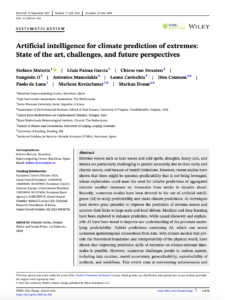Abstract
Extreme events such as heat waves and cold spells, droughts, heavy rain, and storms are particularly challenging to predict accurately due to their rarity and chaotic nature, and because of model limitations. However, recent studies have shown that there might be systemic predictability that is not being leveraged, whose exploitation could meet the need for reliable predictions of aggregated extreme weather measures on timescales from weeks to decades ahead. Recently, numerous studies have been devoted to the use of artificial intelligence (AI) to study predictability and make climate predictions. AI techniques have shown great potential to improve the prediction of extreme events and uncover their links to large-scale and local drivers. Machine and deep learning have been explored to enhance prediction, while causal discovery and explainable AI have been tested to improve our understanding of the processes underlying predictability. Hybrid predictions combining AI, which can reveal unknown spatiotemporal connections from data, with climate models that provide the theoretical foundation and interpretability of the physical world, have shown that improving prediction skills of extremes on climate-relevant timescales is possible. However, numerous challenges persist in various aspects, including data curation, model uncertainty, generalizability, reproducibility of methods, and workflows. This review aims at overviewing achievements and challenges in the use of AI techniques to improve the prediction of extremes at the subseasonal to decadal timescale. A few best practices are identified to increase trust in these novel techniques, and future perspectives are envisaged for further scientific development.
Authors
Stefano Materia (BSC), Lluís Palma García (BSC), Chiem van Straaten (Vrije Universiteit Amsterdam), Sungmin O, Antonios Mamalakis, Leone Cavicchia, Dim Coumou (Vrije Universiteit Amsterdam), Paolo de Luca (BSC), Marlene Kretschmer (University of Leipzig), and Markus Donat (BSC).
